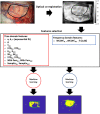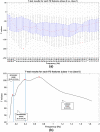Intraoperative thermal infrared imaging in neurosurgery: machine learning approaches for advanced segmentation of tumors
- PMID: 36715852
- PMCID: PMC10030394
- DOI: 10.1007/s13246-023-01222-x
Intraoperative thermal infrared imaging in neurosurgery: machine learning approaches for advanced segmentation of tumors
Abstract
Surgical resection is one of the most relevant practices in neurosurgery. Finding the correct surgical extent of the tumor is a key question and so far several techniques have been employed to assist the neurosurgeon in preserving the maximum amount of healthy tissue. Some of these methods are invasive for patients, not always allowing high precision in the detection of the tumor area. The aim of this study is to overcome these limitations, developing machine learning based models, relying on features obtained from a contactless and non-invasive technique, the thermal infrared (IR) imaging. The thermal IR videos of thirteen patients with heterogeneous tumors were recorded in the intraoperative context. Time (TD)- and frequency (FD)-domain features were extracted and fed different machine learning models. Models relying on FD features have proven to be the best solutions for the optimal detection of the tumor area (Average Accuracy = 90.45%; Average Sensitivity = 84.64%; Average Specificity = 93,74%). The obtained results highlight the possibility to accurately detect the tumor lesion boundary with a completely non-invasive, contactless, and portable technology, revealing thermal IR imaging as a very promising tool for the neurosurgeon.
Keywords: Brain tumor segmentation; Classification; Machine learning; Neurosurgery; Thermal infrared imaging.
© 2023. The Author(s).
Conflict of interest statement
The authors have no relevant financial or non-financial interests to disclose.
Figures







Similar articles
-
Machine learning distinguishes neurosurgical skill levels in a virtual reality tumor resection task.Med Biol Eng Comput. 2020 Jun;58(6):1357-1367. doi: 10.1007/s11517-020-02155-3. Epub 2020 Apr 11. Med Biol Eng Comput. 2020. PMID: 32279203
-
Prediction of Postoperative Speech Dysfunctions in Neurosurgery Based on Cortico-Cortical Evoked Potentials and Machine Learning Technology.Sovrem Tekhnologii Med. 2022;14(1):25-32. doi: 10.17691/stm2022.14.1.03. Epub 2022 Jan 28. Sovrem Tekhnologii Med. 2022. PMID: 35992997 Free PMC article.
-
A Brief History of Machine Learning in Neurosurgery.Acta Neurochir Suppl. 2022;134:245-250. doi: 10.1007/978-3-030-85292-4_27. Acta Neurochir Suppl. 2022. PMID: 34862547
-
Machine learning applications to clinical decision support in neurosurgery: an artificial intelligence augmented systematic review.Neurosurg Rev. 2020 Oct;43(5):1235-1253. doi: 10.1007/s10143-019-01163-8. Epub 2019 Aug 17. Neurosurg Rev. 2020. PMID: 31422572
-
Uncharted Waters of Machine and Deep Learning for Surgical Phase Recognition in Neurosurgery.World Neurosurg. 2022 Apr;160:4-12. doi: 10.1016/j.wneu.2022.01.020. Epub 2022 Jan 11. World Neurosurg. 2022. PMID: 35026457 Review.
Cited by
-
Excessive lipid production shapes glioma tumor microenvironment.Ultrastruct Pathol. 2024 Sep 2;48(5):367-377. doi: 10.1080/01913123.2024.2392728. Epub 2024 Aug 19. Ultrastruct Pathol. 2024. PMID: 39157967
-
Detection of face motor activation in the precentral gyrus with functional thermography following inconclusive direct electrical stimulation mapping: illustrative case.J Neurosurg Case Lessons. 2024 Nov 18;8(21):CASE24549. doi: 10.3171/CASE24549. Print 2024 Nov 18. J Neurosurg Case Lessons. 2024. PMID: 39556814 Free PMC article.
-
Intraoperative Imaging and Optical Visualization Techniques for Brain Tumor Resection: A Narrative Review.Cancers (Basel). 2023 Oct 9;15(19):4890. doi: 10.3390/cancers15194890. Cancers (Basel). 2023. PMID: 37835584 Free PMC article. Review.
-
Excessive Lipid Production Shapes Glioma Tumor Microenvironment.Res Sq [Preprint]. 2023 Dec 12:rs.3.rs-3694185. doi: 10.21203/rs.3.rs-3694185/v1. Res Sq. 2023. Update in: Ultrastruct Pathol. 2024 Sep 2;48(5):367-377. doi: 10.1080/01913123.2024.2392728. PMID: 38168422 Free PMC article. Updated. Preprint.
-
Thermosensitive/thermochromic silicone and infrared thermography mapping in 60 consecutive cases of epilepsy surgery.Surg Neurol Int. 2024 Mar 1;15:63. doi: 10.25259/SNI_763_2023. eCollection 2024. Surg Neurol Int. 2024. PMID: 38468653 Free PMC article.
References
MeSH terms
LinkOut - more resources
Full Text Sources
Medical
